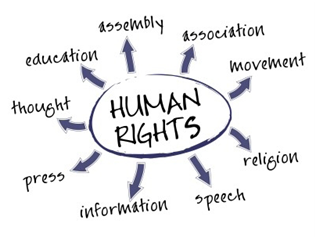1. A free, fair and timely dispute resolution service
2. Types/ grounds include – age, carer and parental status, disability, gender identity, marital status, pregnancy, religion, sex
Places/ areas – accommodation, clubs, education, employment/ workplace, goods and services, land sales and transfers, local government, sport
How to make a complaint – phone call, lodge an online complaint, fill in a complaint form

Legislation – The Equal Opportunity Act 2010, The Racial and Religious Tolerance Act 2001, Charter of Human Rights and Responsibilities Act 2006
3. 20 basic human rights –
- the right to equality before the law and to be treated equally because everyone is entitled to equal protection against discrimination, and to enjoy their human rights without discrimination.
- right to life
- right to protection from torture and cruel, inhuman or degrading treatment
- right to freedom of movement
- right to privacy and reputation
- right to freedom of expression
- right to peaceful assembly and freedom of association
- right to taking part in public life
- right to freedom from forced work
- right to be safe from violence and abuse
- right to a fair hearing
- property rights
- cultural rights
- right to freedom of thought, conscience, religion and belief
- right not to be tried or punished for a crime more than once
- right to be part of a family and protection of families and children
- right to have your privacy respected
- right to liberty and security of person
- right to humane treatment when deprived of liberty
- rights of children in the criminal process
Responsibilities –
The Charter protects 20 human rights in Victoria in three main ways:
- Public authorities, such as a hospital or public school, must act in ways that are compatible with human rights
- Human rights must be taken into account when developing new laws because when new laws are introduced into Victorian Parliament a Statement of Compatibility must be tabled in Parliament outlining how the proposed law meets the standards set out in the Charter.
- Courts must interpret and apply all laws compatibly with human rights
Commission’s role –to help people in Victoria understand the rights and freedoms set out in the Charter and what they can do to make them an everyday reality, and to provide a regular and independent assessment of the steps taken by the Victorian Government, local councils and other public authorities to meet their responsibilities under the Charter.
4. Types of workplace discrimination –refer to types listed above
Sexual harassment – Sexual harassment is against the law under the Equal Opportunity Act 2010.
Sexual harassment is unwelcome sexual behaviour, which could be expected to make a person feel offended, humiliated or intimidated. It can be physical, verbal or written.
Sexual harassment is not consensual interaction, flirtation or friendship. Sexual harassment is not behaviour that is mutually agreed upon.
Sexual harassment is covered in the workplace when it happens:
- at work
- at work-related events or where people are carrying out work-related functions
- between people sharing the same workplace
Bullying – Bullying and harassment can be discrimination when it happens because of someone’s disability, race, sexual orientation, age, physical features or any other protected attribute under the Equal Opportunity Act 2010. Bullying and harassment can be verbal, physical or in writing, and includes behaviour that intimidates, degrades or humiliates another person. This can be a form of unfavourable treatment covered by the law.
WorkSafe Victoria has more information on bullying at work.
